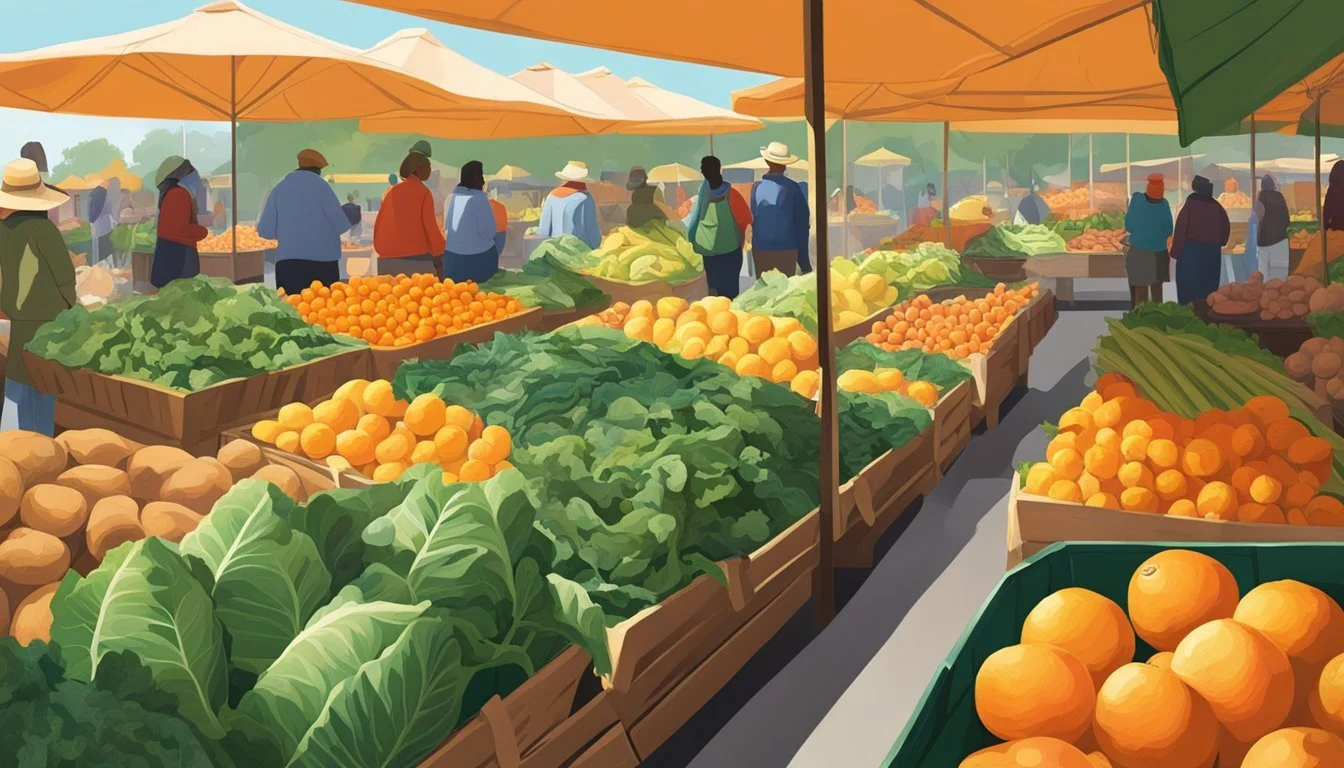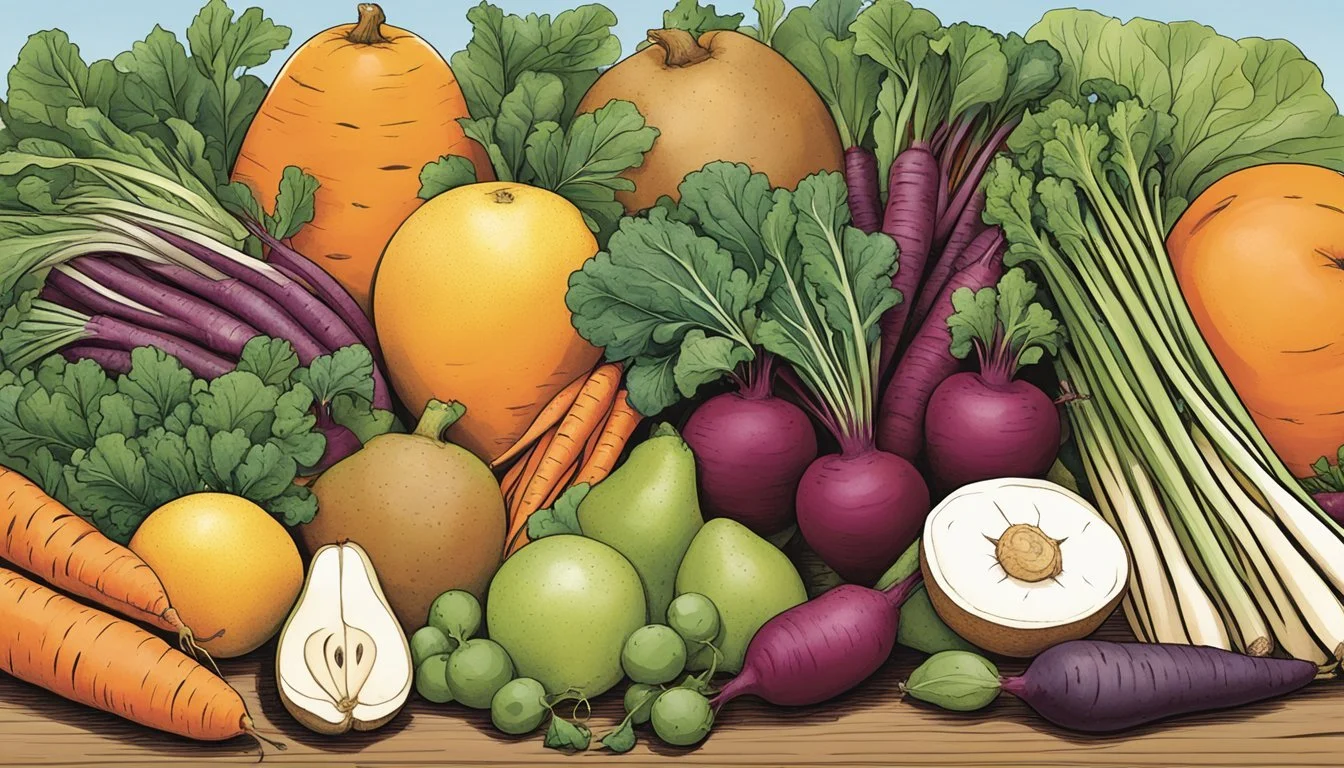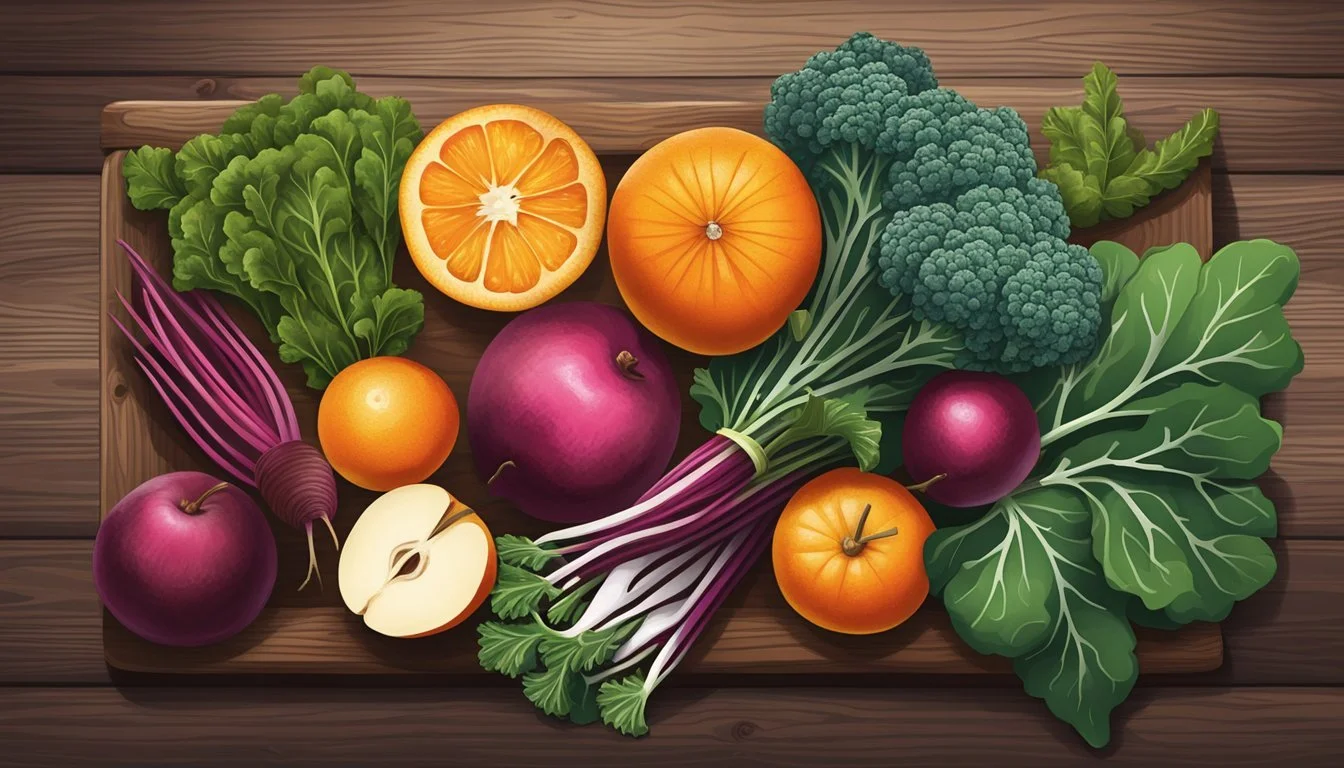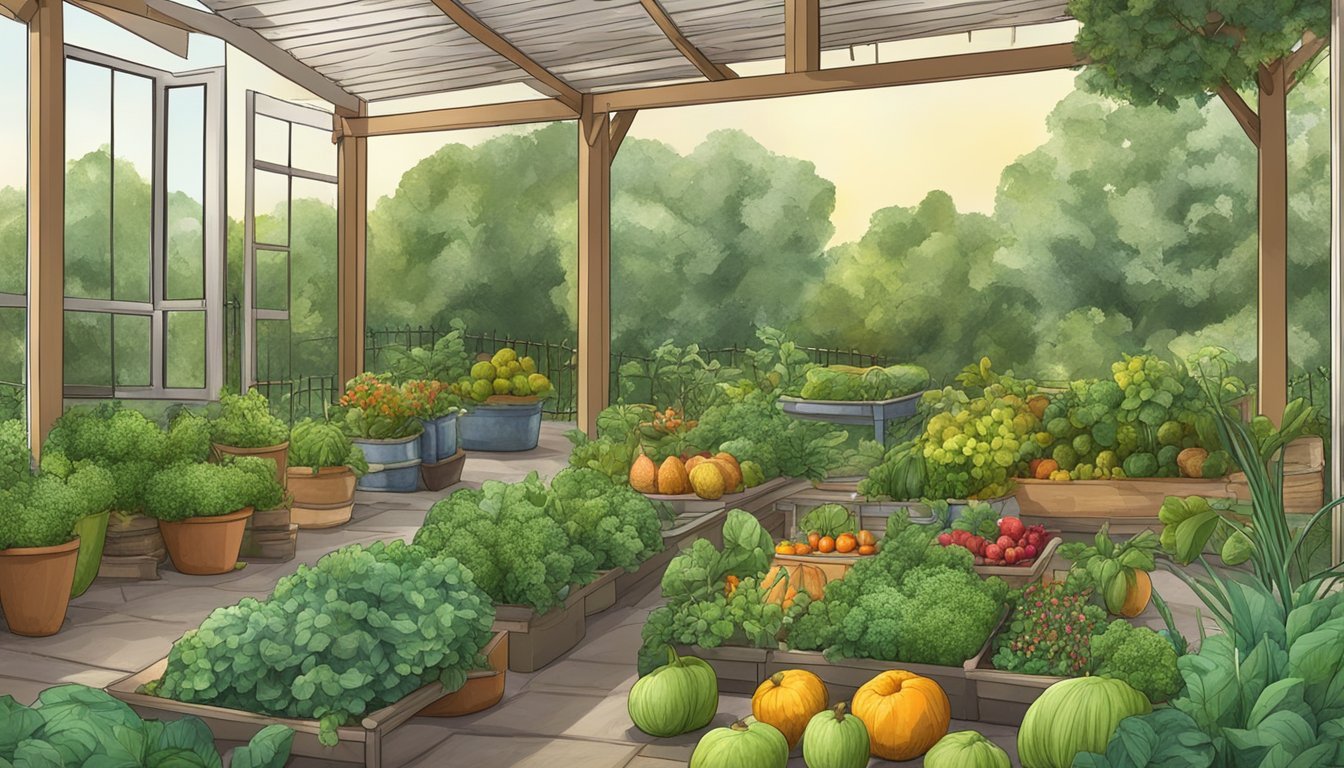Alabama Seasonal Fruit & Vegetables in January
A Fresh Start to the Year
This Article is Part of our Alabama Seasonal Fruit & Veg Calendar
January in Alabama marks a period where the selection of seasonal produce is more limited due to the colder weather. However, even during these cooler months, Alabama's agriculture continues to yield a variety of fresh produce. Among the offerings are hearty greens, which remain a staple in local cuisine and are known for their nutritional value and versatility in many dishes.
Root vegetables also thrive in the January chill, providing depth and flavor to winter meals. Sweet potatoes, a nutrient-dense tuber, are one such crop that is readily available during this time, often featured in both savory and sweet applications. Additionally, pecans (how long do pecans last?) are harvested in the late fall and continue to be available in January, frequently used in traditional Southern recipes.
Local herbs are more resilient than one might expect, with many varieties such as rosemary and thyme remaining accessible throughout the month. They play a critical role in elevating the flavors of seasonal dishes, reflecting Alabama's rich culinary heritage. The state's agricultural flexibility ensures that even in the heart of winter, there is no shortage of locally grown produce to enrich the diets of residents and visitors alike.
Season Overview
In Alabama, January presents a unique confluence of winter weather conditions and a range of available fruits and vegetables for harvest. This month necessitates a deep understanding of seasonal produce, its nutritional value, and how local conditions affect harvest timings.
January Climate and Harvest Conditions in Alabama
January in Alabama is characterized by its cool to cold weather patterns, which influence what crops are harvested. Auburn University's horticultural experts, like Kerry Smith and Dave Williams, acknowledge that Alabama's diverse climate plays a significant role in dicturing growing seasons across the state.
Fruit and Vegetable Seasonality
During January, Alabamians see a variety of winter vegetables and, to a lesser extent, fruits that are able to thrive. Typical vegetables available include:
Root Vegetables: carrots (how long do carrots last?), beets
Leafy Greens: collard greens, kale (What wine goes well with kale?)
Cruciferous Vegetables: cabbage, broccoli
Fruits are less abundant, but some, such as apples, may still be available from fall harvests or storage.
Importance of Eating Seasonal Produce
Eating seasonally in January ensures one receives produce at its peak nutritional value and flavor. Extension horticulturist Frances Sledge suggests seasonal produce also supports local farms by reducing the carbon footprint associated with long-distance transportation.
Impact of Weather on Seasonal Varieties
Alabama's weather can greatly affect which fruits and vegetables are in season. The state's winter may range from mild to severe cold snaps, influencing not only the types of crops that can be grown but also their flavor profiles and nutritional content.
Seasonal Harvest Timings
Local farm harvests in Alabama have adapted to the cooler January climate. Hardier crops tend to dominate the fields, and many farmers deploy protective measures to extend the growing season of certain crops, effectively managing the transition from winter to spring.
Extension Resources
The Alabama Cooperative Extension System is a valuable resource for understanding seasonal produce. Extension associates like Ron Shumack offer guidance through publications and services to both consumers and farmers, informing them about optimal planting dates and harvest times in alignment with January’s conditions.
Seasonal Fruit Availability
In Alabama during January, residents enjoy a variety of seasonal fruits. The produce is at its peak, offering the best flavors and nutritional value.
Citrus Fruits and Their Peak Season
Citrus fruits thrive in the cooler months, reaching peak ripeness in January. Oranges, including navel and blood oranges, and grapefruits are especially juicy and sweet during this time.
Oranges: Peak season from December to April
Lemons: Best from fall through early spring
Limes: Widely available year-round but peak in winter
Tree Fruits in Season
While many tree fruits are not in peak season, Alabama's winter climate still supports some.
Apples: Late varieties may still be available.
Pears: Some varieties are stored and sold throughout the winter.
Berry Varieties Available
Berry season in Alabama is typically during warm months, but:
Strawberries: A few hothouse-grown strawberries might be found.
Blueberries & Blackberries: Not in season until late spring and summer.
Seasonal Vegetable Availability
In January, Alabama's cooler temperatures support a variety of hearty vegetables. The seasonal availability centers around robust root vegetables, nutritious leafy greens, and an array of cruciferous vegetables.
Root Vegetables and Tubers
January is an ideal time for harvesting root vegetables and tubers in Alabama. The earth provides a natural insulation, allowing these vegetables to be sweet and flavorful.
Sweet Potatoes: Possessing a rich, creamy texture, they are a staple in southern cooking.
Potatoes: A versatile kitchen ingredient, they remain a favorite for their adaptability in recipes.
Carrots: Known for their crunchy texture and sweet taste, perfect for stews and side dishes.
Beets: Earthy and deep in flavor, they're suitable for roasting or as an addition to salads.
Radishes and Parsnips: These provide a sharp taste and are often used to enhance the flavors of a dish.
Celery Root: A less common, yet flavorful, option for soups and mashes.
Leafy Greens and Their Harvest
The colder months contribute to the tenderness and richness of leafy greens, with almost a sweeter note due to the cold.
Lettuce: It thrives in the cooler weather, offering a crisp addition to salads.
Kale and Collards: These greens are sturdy and nutritious, perfect for hearty dishes that require greens that can withstand cooking.
Mustard (how long does mustard last?) and Spinach: Offering a tangy flavor, they are often enjoyed raw or lightly sautéed.
Cruciferous Vegetables in January
These vegetables, known for their health benefits, grow well during the cooler months in Alabama.
Broccoli: With its distinct taste, it's commonly used in both raw and cooked forms.
Cabbage: A versatile vegetable, used in slaws, sautéed dishes, (What Wine Pairs Best with Sautéed Dishes) or fermented to make sauerkraut (how long does sauerkraut last?).
Cauliflower and Brussels Sprouts: These can be roasted to bring out a nutty, sweet taste.
Other Vegetables in Season
Other vegetables that thrive in January in Alabama include:
Turnips: Their roots are often mashed or roasted, while their greens can be used similarly to collards.
Asparagus and Peas: Although not at their peak, these can sometimes be found in Alabama's milder winters.
Agricultural Practices
In Alabama during January, agricultural practices focus on adapting to the cooler weather, which impacts the planting schedules and crop management. Farmers prioritize soil health and prepare for the potential impact of winter weather on crops.
Winter Planting Schedule
Alabama farmers use January to plant specific vegetables that can endure the cold. Seeds for greens, such as collards, kale, and mustard, are sown during this time due to their cold-tolerance. Indoor plantings begin for crops that require a head start before spring transplanting, such as tomatoes and peppers.
Gardening Activities and Crop Management
Pruning of fruit trees and berry bushes is essential in January to promote healthy growth and productivity. Gardening activities continue as farmers engage in mulching to protect root systems against freezing temperatures and retain soil moisture. Crop rotation practices are also planned during this period to prevent soil depletion in the upcoming growing seasons.
Soil and Nutrient Management
Soil testing is a key activity in January as it informs farmers about nutrient requirements and pH levels. Based on the results, farmers apply appropriate fertilizers to replenish nutrients. Adding organic matter, such as compost, helps in improving soil structure and fertility before spring planting.
Weather Preparation Strategies
Alabama farmers must remain vigilant of the winter weather conditions. They adopt strategies to shield sensitive plants from frost and employ row covers to protect outdoor plantings. Installation of windbreaks and utilization of greenhouses or hoop houses can safeguard crops against sudden temperature drops.
These practices employed in January are integral to the success of the agricultural season in Alabama, ensuring that despite the cold, the groundwork for a productive year is well established.
Culinary Uses and Recipes
In Alabama, January's seasonal produce selection inspires diverse culinary uses and recipes, from bright citrus-flavored dishes to hearty vegetable soups and salads.
Cooking with Seasonal Produce
Citrus fruits are a January highlight, and in Alabama, they can be used to add a zesty twist to dishes. Oranges and grapefruits serve well in vinaigrettes or glazes. For instance, a simple Citrus Honey Glaze can elevate roasted chicken (What wine goes well with roasted chicken?) or pork chops. (What wine goes well with pork chops?)
Citrus Honey Glaze Recipe:
Combine equal parts freshly squeezed citrus juice and honey.
Season with salt, pepper, and a hint of garlic.
Brush onto the meat before the last few minutes of cooking.
Incorporating Fruits into Meals
Fruits like apples and pears are versatile, transitioning from sweet to savory uses seamlessly. They can be used in salads, like a Winter Fruit Salad, or turned into a warm apple compote that complements both breakfast and dessert dishes.
Winter Fruit Salad:
Mixed greens
Thinly sliced apples and pears
A sprinkle of walnuts (how long do walnuts last?)
Crumbled feta or blue cheese
Drizzle with a light balsamic dressing
Vegetable-Based Dishes and Preparations
Root vegetables, including carrots and sweet potatoes, are readily available and perfect for hearty soups and stews. Alabama's winter recipes often feature these as base ingredients, such as in a Carrot Ginger Soup or a Roasted Sweet Potato Salad.
Carrot Ginger Soup Recipe:
Sauté chopped onions, carrots, and fresh ginger until soft.
Add vegetable stock and seasonings, then blend until smooth for a warming winter soup.
Vegetables are also the foundation of many fresh produce dishes such as roasted veggie platters or stir-fries, which allow their natural flavors to shine through.
Educational Resources and Events
For those interested in seasonal fruits and vegetables in Alabama, numerous educational opportunities are at hand to enhance understanding and skills, ranging from university-led programs to local culinary classes.
University Extension Programs
Auburn University's Alabama Cooperative Extension System is a prime educational resource, offering extensive programs on local agriculture. Extension associates and horticulturists frequently conduct seminars on the seasonal availability of produce. Participants receive valuable guidance on plant spacing, maturity times, and optimal harvesting periods.
Local Farming Workshops and Tours
Local farms across Alabama provide hands-on workshops and tours aimed at both adults and children. These events often include field trip guides and offer a practical perspective on farming techniques. Attendees can observe and learn the best practices for growing seasonal fruits and vegetables appropriate for the month of January.
Seasonal Cooking Classes
Various institutions and culinary experts conduct cooking classes focusing on seasonal recipes. These classes teach individuals how to select and utilize January's fresh produce like collards, kale, and mustard greens. Cooking enthusiasts appreciate learning how to incorporate fresh, local ingredients into their meals, enriching both flavor and nutritional value.
Health and Nutrition
Eating seasonal fruits and vegetables in Alabama during January brings notable health benefits due to their high nutritional value and maximal flavor. They offer a natural way to receive necessary vitamins and minerals, and can be incorporated into various recipes.
Benefits of Seasonal Fruits and Vegetables
Seasonal fruits and vegetables are often fresher, provide a more robust flavor, and have their peak nutrient profiles during their natural harvest time. For instance, citrus fruits like oranges and grapefruits, which are in season during January in Alabama, are rich in vitamin C and flavonoids. These nutrients aid in immune function and heart health. One also finds root vegetables like sweet potatoes and turnips, which are dense in dietary fiber and antioxidants, supporting digestive health and helping to reduce inflammation.
Crucial minerals such as potassium, found in bananas and spinach, maintain electrolyte balance and are vital for muscle function. Including these seasonal foods in one's diet can enhance overall health while supporting local agriculture.
Dietary Planning with Seasonal Produce
Planning meals around seasonal produce can lead to more nutritionally diverse menus. By focusing on what is fresh, consumers can enjoy a variety of flavors and nutrition benefits. For example, incorporating kale and collard greens, which thrive in January's cooler temperatures, add essential vitamins A, C, and K to one's diet, crucial for eyesight, skin health, and blood clotting.
Utilizing seasonal vegetables like winter squash in recipes provides a sweet, nutty flavor and offers a good source of vitamin A and C, with the added benefit of being versatile in a range of dishes from soups to roasted sides. Nutrient-dense produce not only contributes to better health but also enhances the culinary experience with natural, vibrant flavors.
Gardening Tips and Techniques
In January, gardeners in Alabama can leverage the mild climate to optimize their garden's performance. It is crucial to follow specific techniques for propagation, maintain existing plants through pruning, and implement measures for pest control to ensure the vitality of both edible and ornamental plants.
Propagation and Cultivation Guides
For gardeners aiming to advance their vegetable gardens, January is an ideal time for seed propagation. Seeds should be selected based on their cold-hardiness and ability to thrive in winter conditions. In Alabama, it's suitable to plant hardy vegetables like garden peas and root crops. Indoor planting may include starting seeds in trays or pots indoors, maintaining a temperature between 55 to 60 degrees Fahrenheit to facilitate germination.
Vegetable Seeds for January:
Hardy vegetables: Garden peas, radishes
Leafy greens: Mustard, spinach, turnips
Pruning and Maintenance Advice
January is also a time to focus on the maintenance of shrubs, roses, and perennials. Pruning is essential; however, the timing and method vary by species. For shrubs, gardeners should remove any dead, diseased, or damaged branches to promote healthy growth. When it comes to roses, they should be pruned to shape the plant and encourage blooming, avoiding any severe pruning until late February or March.
Pruning Tips:
Shrubs: Clean cuts on dead or damaged branches
Roses: Light shaping; delay major pruning
Pest Control and Prevention
Pests like slugs can pose a significant threat to January crops, especially when the weather is cool or wet. Gardeners should be vigilant and use environmentally friendly methods to protect their plants. They can expect slugs in damp soil conditions, so planting in partial shade, where the soil tends to retain moisture, can make lettuce and similar crops susceptible. Utilizing natural deterrents or barriers can help in preventing slug damage.
Pest Prevention Strategies:
Utilize organic slug repellents
Plant in well-draining areas to prevent damp conditions









